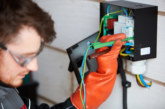
Mark Wilkins, Vaillant’s Technologies and Training Director, considers how heating the country’s existing homes could be achieved using hydrogen and heat pumps, and looks at the considerations both technologies face.
Following recommendations from The Climate Change Committee, the Government tightened its previous target to reach a 68% reduction in carbon emissions by 2030, compared with 1990 levels, to 78% by 2035. It was recognised that to achieve this goal, low-carbon heating will be needed. While interim standards will be coming into effect next year for new domestic properties, questions remain around what the energy mix should look like to decarbonise heat in the UK’s existing homes.
Hy hopes
Until the Government reveals more details in its Hydrogen Strategy due later this year and starts consulting on its preferred business models for hydrogen, many questions remain on how our country will sustainably produce the hydrogen needed to decarbonise many parts of our economy. However, from the roadmap revealed in the ‘Ten Point Plan for a Green Industrial Revolution’, it is clear that hydrogen boilers will be unable to contribute to our 78% carbon reduction target by 2035. As by this time, these solutions will only be starting to come on board.
According to the ten-point plan, a hydrogen heating trial for a large village won’t begin until 2025. By 2030, there will only be a pilot hydrogen town if the Government’s plans go ahead, and the trials are successful. Even if the pilot proves successful, it will take more than five years to supply every home on the gas network with hydrogen-only fuel.
In the mix
Supposing that trials on blending up to 20% of hydrogen into the gas distribution grid can be successfully completed by 2023, it would be technically possible to supply all homes on the gas network with this blend. Indeed, the indications are that all condensing boilers, which have been on the market since 2005, should be suitable for use with up to 20% hydrogen and 80% natural gas. This has been proven possible by the HyDeploy programme at Keele University and will be further supported by the HyDeploy 2 programme which is being set up in Winlaton. It is believed that any modern boiler sold today can run effectively and safely on this blend, which means that carbon reductions can be made within the lifetime of existing boilers, without needing to upgrade to hydrogen-only heating appliances.
There are, however, a number of hurdles. Firstly, although the Government hopes to have the production capacity to produce 1GW of green hydrogen by 2025 and 5GW by 2030, it has been suggested that much of this could be allocated for use in freight, transport, aviation and other industries, leaving an insufficient amount to be blended into the mains gas network. Secondly, many argue that the cost of producing green hydrogen is so high that it is uneconomical to blend it with mains gas. Producing hydrogen by reforming fossil fuels is cheaper, but is not truly sustainable, and the resulting carbon emissions will have to be captured and stored to mitigate the environmental impact.
Even if sufficient green hydrogen is produced and becomes commercially viable to be blended with natural gas, the total amount of carbon reduction achievable by the blend will only be up to 7%. This amount of reduction is still worthwhile, but it does mean that further carbon savings need to be made via the use of heat pumps, heat networks and hybrid systems, providing heat to homes both on and off the mains gas network.
Heat pumps
Heat pumps have zero emissions at point-of-use and meet both heating and hot water needs. The electricity used to power the units is increasingly being produced via renewable and low carbon means. What’s more, the absence of combustion in heat pumps means that they help reduce air pollution. So once energy demand in the home is reduced through good insulation, heat pumps can provide a low carbon and cost-effective solution across many different applications in both on and off-gird areas.
Households in on-grid areas have enjoyed lower-cost gas prices compared to electricity for many years, resulting in a lack of financial incentive to change to low-carbon heating sources. But with plans to introduce the Green Gas Levy to fund biomethane injection into the gas grid, pricing differences may tip in favour of electricity in the near future, further encouraging the adoption of heat pump technologies. This is likely to happen sooner in the social housing sector, as housing providers will need to start making plans now to mitigate the impact of future gas price increases on tenants. With funding available from the Local Authority Delivery scheme and Social Housing Decarbonisation Fund, fabric improvements can be made to reduce heat loss, before changing to low-carbon heating technologies powered by electricity such as heat pumps, to minimise the risk of fuel poverty in the years to come.
To ensure widescale and viable uptake of low carbon technologies, support and investment in installers and electrical infrastructure will be crucial. Homeowners must also be taken along on this journey, with a better understanding of the costs and the differences in heating technologies. The fact remains that to meet the Government objective to install 600,000 heat pumps a year by 2028, we need more quality, trained installers to deliver these systems. Vaillant has been working with other manufacturers and the Heat Pump Association to develop and deliver a low carbon training plan to support heat pump engineers, because easier access to local installers will be key to the successful deployment of heat pumps across the whole country.
Inventive incentive
Although schemes are available to support housing providers with the upfront cost to retrofit low carbon solutions such as heat pumps, it is essential the Government look to financially support homeowners to make the necessary changes to their properties too. Which is why it was a huge disappointment that the Green Homes Grant (GHG) closed so abruptly. Apart from the Renewable Heat Incentive, which will end in March next year and is expected to be succeeded by the Clean Heat Grant, there is currently no other government funding initiative – whether in the form of scrappage schemes, subsidised financing options or tax incentives. For those who are concerned about the capital cost of decarbonising their heating system, funding which covers a significant percentage of the financial outlay could make the difference between choosing another fossil-fuel based boiler or a low carbon solution.
At the moment, hydrogen is very much in the testing phase. On its own, neither the technology nor the business model will be developed enough for it to make a significant contribution to the 78% reduction target, however, longer term it is clear it will have a key role to play. It is hoped that the Net Zero Strategy, Heat and Buildings Strategy and UK Hydrogen Strategy, will give greater clarity when they are unveiled later this year, and give guidance to the industry of where focus is needed to decarbonise heat in the country’s existing housing stock, be that in heat pumps, heat networks, hydrogen-ready boilers or hybrid options. Much work is already going on in the background, but it is important that the industry tasked with making many of these changes is fully consulted to ensure success.








